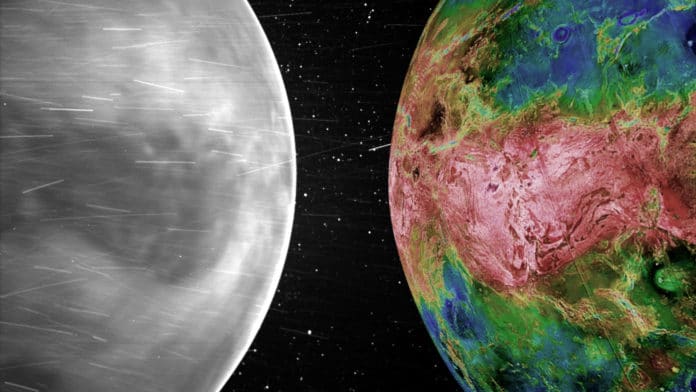Venus’s surface is peppered with intensely crunched mountains and thousands of large volcanoes. As NASA reported, its surface is rusty, smothered in thick clouds.
Using its Wide-Field Imager, or WISPR, Parker Solar Probe has captured its first visible-light images of Venus’s surface. The images revealed a faint glow from the surface, showing distinctive features like continental regions, plains, and plateaus. It also offers a glowing halo of oxygen in the atmosphere surrounding the planet.
As NASA reported, these first visible-light images of Venus’s surface can help scientists understand more about Venus’s surface geology. It also helps them know minerals might be present there and the planet’s evolution.
Nicola Fox, division director for the Heliophysics Division at NASA Headquarters, said, “We’re thrilled with the science insights Parker Solar Probe has provided thus far. Parker continues to outperform our expectations, and we are excited that these novel observations taken during our gravity assist maneuver can help advance Venus research in unexpected ways.”
The probe captured the first images in July 2020 during its third flyby. Besides seeing through the clouds, the probe also peers through the surface of the planet.
The images were so striking that the scientists turned on the cameras again during the fourth flyby in February 2021. As it passed by Venus, WISPR picked up a range of wavelengths from 470 nanometers to 800 nanometers. Some light is near-infrared – wavelengths that can not be seen but sense as heat, whereas some light, is in the visible range.
Wood said, “The surface of Venus, even on the nightside, is about 860 degrees. It’s so hot that the rocky surface of Venus is visibly glowing, like a piece of iron pulled from a forge.”
The WISPR images show features on the Venusian surface, such as the continental region Aphrodite Terra, the Tellus Regio plateau, and the Aino Planitia plains. Since higher altitude regions are around 85 degrees Fahrenheit cooler than lower regions, they appear as dark patches amidst the brighter lowlands.
Scientists combined these first images with previous ones. By doing so, they obtained a wider range of wavelengths to study. This could help them identify the mineralogy on the planet’s surface.
Along with glowing surfaces, the images show a bright ring around the planet’s edge caused by oxygen atoms emitting light in the atmosphere. This type of light is known as airglow.
WISPR has also imaged Venus’ orbital dust ring. On the other side, the FIELDS instrument measured the radio waves in the Venusian atmosphere. This measurement is expected to help scientists understand how the upper atmosphere changes during the Sun’s 11-year cycle of activity.
Lori Glaze, director of the Planetary Science Division at NASA Headquarters, said, “By studying the surface and atmosphere of Venus, we hope the upcoming missions will help scientists understand the evolution of Venus and what was responsible for making Venus inhospitable today. While both DAVINCI and VERITAS will use primarily near-infrared imaging, Parker’s results have shown the value of imaging a wide range of wavelengths.”
Journal Reference:
- Brian E. Wood et al. Parker Solar Probe Imaging of the Night Side of Venus. DOI: 10.1029/2021GL096302
